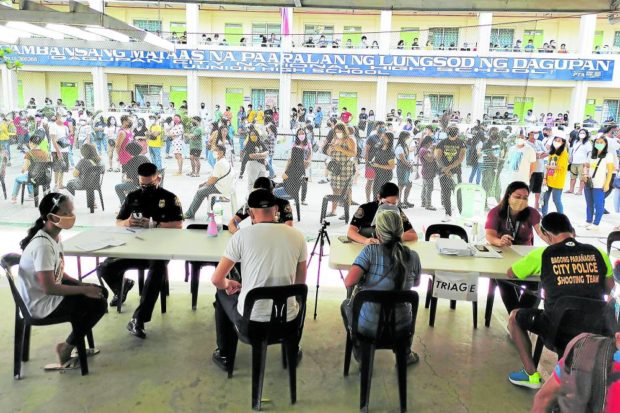Ilocos Region now at ‘critical risk’ for COVID-19 – DOH

WAITING IN LINE In Dagupan City, residents endure the queue so they can avail of COVID-19 vaccines at Dagupan City National High School in this photo taken during the national vaccination drive on Dec. 1 last year. The school served as one of four nonhospital-based vaccination centers in Dagupan, one of the major commercial areas in Ilocos region. —WILLIE LOMIBAO
SAN FERNANDO CITY, La Union — The Ilocos Region has been classified by the Department of Health (DOH) as “critical risk” for COVID-19 transmission due to an alarming surge in infections in the first half of January.
In an advisory on Tuesday, the DOH said the COVID-19 weekly growth rate in the region from Dec. 21, 2021 to Jan. 17, 2022 was at 3,362 percent, with over 7,000 active cases logged on Monday.
The average daily attack rate (Adar) in the region was also at high risk at 36.65 per 100,000 population from Jan. 4 to Jan. 17 compared to 1.18 from Dec. 21, 2021 to Jan. 3, 2022, the DOH said. Adar is the number of individuals found infected for every 100,000 people.
At least six patients infected with the highly transmissible Omicron variant of COVID-19 had been detected in the region, with four in Pangasinan and one each in Ilocos Norte and La Union, the DOH said.
Hospital bed occupancy
But Dr. Rheuel Bobis, COVID-19 response coordinator of the DOH in the Ilocos, said it was too early to attribute the increase in cases to the presence of Omicron in several areas in the region.
Article continues after this advertisementHe said the virus surge during the first two weeks of January could be due to the increased risk of exposure to the virus and the public’s mobility during the holiday season when most areas had eased quarantine protocols.
Article continues after this advertisement“So we have to monitor and assess [the situation] in the coming weeks,” Bobis said on Wednesday.
Data from the DOH also showed that despite the spike in infections, the total bed utilization rate in the region was still under moderate risk level with 52.49 percent of the 2,050 total COVID-19 beds used as of Jan. 16.
ICU utilization rate
The utilization rate for intensive care unit (ICU) beds was also under moderate risk as only 50.92 percent of the 218 total beds had been occupied.
All provinces in the region—Ilocos Norte, Ilocos Sur, La Union and Pangasinan—remains under the more stringent alert level 3 until Jan. 31.
In Baguio City, two cases of Omicron infections had been officially recorded in the summer capital, which posted 3,990 active COVID-19 cases as of Tuesday.
The DOH in the Cordillera on Wednesday said the genome sequencing results released on Jan. 15 traced the presence of the variant to a patient who tested positive for COVID-19 on Dec. 24, 2021, and an asymptomatic patient who was confirmed to have contracted the disease on Dec. 15, 2021.
They had no travel histories prior to contracting the virus, although the asymptomatic patient was the close contact of another COVID-19 patient.
Mayor Benjamin Magalong said protocols to manage the spike in infections assumed that the highly transmissible variant was already in the city since last week.